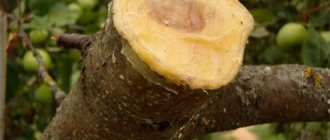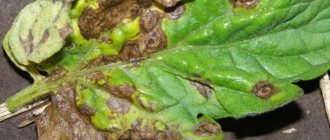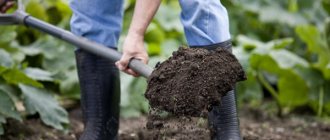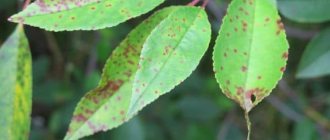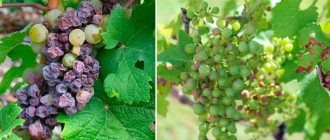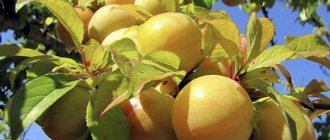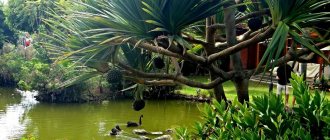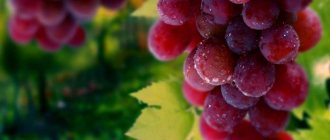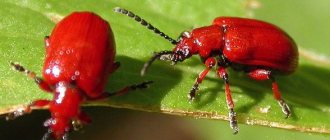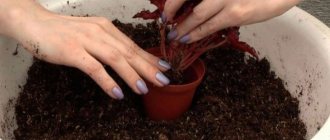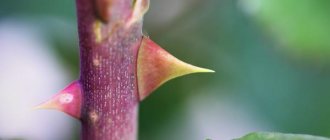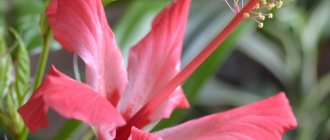A fruit-bearing garden is the special pride of a zealous owner. Every gardener knows how difficult it is to achieve such a result. If sanitary conditions are not observed, green spaces quickly turn into a problem. The main culprits of neglect in the garden are usually pests of fruit trees. A huge number of insects can multiply even more in a short period of time and literally occupy the garden. Let's try to figure out how to deal with bugs, caterpillars and other “aggressors”.
Pests of raspberries, blackberries and strawberries
For your attention - the most common representatives of the fauna, which, like many summer residents, are not averse to profiting from sweet berries (and not only them).
| Pest | How to recognize | Control measures |
| Strawberry whitefly | Adult insects “nest” on the underside of leaves. Honeydew (honeydew) is noticeable on the surface of the leaf; later, black spots of sooty fungus spores are visible in its place. | Biological The pest is washed off the leaves with water, then the soil is loosened to a depth of 2-3 cm. Traps are made: a sheet of plywood is painted yellow and smeared with Vaseline. The leaves are treated with a soap solution: 1 part soap shavings to 6 parts water. The parasite encarsia is released into the garden (3 individuals per 1 sq.m.). Chemical Spraying plants with Alatar, Aktara, Biotlin Bau, Inta-Vir. |
| Strawberry nematode | The insect settles in the axils of leaves and buds. Ovaries, buds and flowers curl and rot. The leaves darken, the petioles turn red. The plant stops growing. | Biological Maintaining crop rotation. Removing weak and diseased plants. Thermal treatment of roots: a bush affected by a nematode is removed from the soil and washed with water or soaked in water at a temperature of 50-55°C. Planting resistant strawberry varieties (for example, Festivalnaya). Chemical Treatment of plants with drugs Skor, Nematofagin. |
| Strawberry mite | The leaves curl, wrinkle and turn yellow, and a waxy coating appears on the surface. Later, the affected parts of the plant die. The pest is more active in northern regions with cold climates than in the south. | Biological Thinning of plantings, regular weeding. Treatment with infusion of onion peel (200 g of peel, pour 10 liters of warm water, leave for 4 days) or garlic extract (200 g of chopped garlic, pour 10 liters of water, stir, strain). Chemical Treatment of plantings with the BioKill insecticide, Fufanon-Nova. |
| Strawberry leaf beetle | The pest eats away the pulp of the leaves, leaving the skin intact. The bush withers, dries up, and stops bearing fruit. | Biological Do not allow strawberries to be adjacent to meadowsweet and cinquefoil - these are the “homes” of the pest. Regular loosening of the soil is mandatory. Chemical Before flowering, the plantings are treated with pesticides: Taran, Fufanon-Nova. |
| Raspberry bud moth | The pest eats away buds and young shoots. The affected parts of the plant dry out. | Biological Thinning of plantings, clearing the area of debris. Treatment of raspberries with wormwood infusion: 800 g of dried herb (or 0.5 buckets of raw) pour 10 liters of water, leave for 24 hours. Then boil, strain, dilute by 2 times. Chemical Before and after flowering, use Fufanon-Nova. |
| Raspberry stem gall midge | The pest lays eggs closer to the base of the stem. A typical sign of damage is swellings (galls) on the stems of the plant. | Biological Affected parts of plants must be removed. The insect is repelled by the smell of garlic and onions, so it is advisable to plant these crops near the raspberry tree. During the growing season, after each generation of the pest, use Bitoxibacillin. Chemical Twice a season, before and after flowering, treat with Fufanon-Nova. |
| Raspberry stem fly | Pest larvae leave tunnels in the shoots. The stems of the plant darken and dry out. | Biological Affected shoots are cut out and burned. In the fall, the soil under the bushes is dug up and pruning is carried out in a timely manner. Chemical Treatment with 1% Bordeaux mixture. Spraying with Iskra Double Effect, Inta-Vir, etc. is effective. |
| Raspberry-strawberry weevil | Small punctures are noticeable on the leaves, the buds weaken and wither (the pest gnaws the pedicels). | Biological Mandatory destruction of plant residues at the end of the season. Treatment with wood ash infusion (pour 3 kg of boiling water over 10 liters, add 40 g of soap shavings, stir, leave for 12 hours). Chemical Before and after flowering, plants are treated with Alatar, Taran, Fury, Fufanon-Nova. |
| Raspberry beetle | The pest larva can be seen by picking a berry from a bush. The insect damages flowers, ovaries, and young leaves. | Biological During deep (20 cm) loosening, tobacco dust is added to the soil. Garlic and onions are planted in raspberry fields to attract predators to the area - hoverflies and ground beetles. Plants are treated with tansy infusion (400 g per 5 liters of water, leave for 24 hours, then boil, strain and dilute to 10 liters). Before flowering, the bushes are sprayed with 2% Bitoxibacillin. Chemical Treatment with Inta-Vir, Kinmiks, Confidor Extra. The approximate consumption of the working solution is 1.5 liters per 10 bushes. |
| Raspberry mite | The mite can be found on the underside of a young leaf. The pest feeds on the sap of the plant, causing the leaves to become deformed and covered with light spots. | Biological Spraying with onion infusion: pour 20 g into 1 liter of water, stir, leave for 7-8 hours, strain. Chemical Treatment of bushes by leaves with Fufanon-Nova, Iskra, etc. (dosage according to instructions). |
- Strawberry pests: how to recognize and fight
Garden strawberries (strawberries) are an attractive “target” for many pests, the most dangerous of which we will talk about today.
- Who eats raspberries - 5 most dangerous pests
What raspberry pests are considered the most dangerous, and why are they so difficult to detect? Find out from the article right now.
Pests of apple and pear trees
But those who unceremoniously invade your domain to feast on some of the most popular garden crops in our latitudes.
| Pest | How to recognize | Control measures |
| Pear gall mite | Light green swellings form on the leaves, which darken over time to a reddish-brown color. The pest “lurks” on the back of the leaf. | Biological In the fall, it is necessary to clean tree trunks of old dead bark and whiten them. Chemical Before the buds bloom, the tree crowns are sprayed with Inta-Vir. In summer the treatment is repeated. |
| Pear bug | Adult insects and larvae suck the juice from the leaves, causing them to become discolored and dry out. In case of mass infestation by the pear bug, trees may stop growing or even die. | Biological Timely removal of the affected bark, cleaning and subsequent destruction of leaf litter. Treatment with Bitoxibacillin or Fitoverm. Chemical During the growing season, trees are sprayed with the following preparations: Aktara, Sumi-alpha. |
| Pear fruit gall midge | Noticeably enlarged ovaries, black and wrinkled fruits. | Biological Removal and destruction of infected ovaries and fruits, treatment with biological products, for example, Bitoxibacillin or Fitoverm. Chemical Spraying during the growing season with chemicals (Iskra Double Effect, Fufanon-Nova, Aivenhoe, Sumi-alpha). |
| Pear fruit sawfly | The larvae feed on the ovaries and eat the seeds. Damaged fruits turn black and fall off. | Biological In early spring and at the end of the season, you need to dig up the soil in the tree trunk circles so that the insects wintering there die. The trunks are cleared of old bark. Chemical Processing Inta-Ts-M, Karbotsin, Fufanon-Nova, Iskra, Alatar, Aliot. |
| Green apple aphid | The plant slows down, the fruits grow small and fall prematurely. Honey dew is noticeable on the leaves. | Biological Regular destruction of root shoots and fattening shoots. Before the buds open, the branches of the tree are treated with a mixture of kerosene and liquid soap (ratio –1:1). Chemical Treating the garden with Qi-Alpha, Movento Energy, Fatrin, Aivengo, Inta-Vir and other insecticides. |
| Goldentail | The pest in the caterpillar stage eats the buds and leaves of trees. | Biological In the fall, you can destroy insects that have settled in for the winter. Nests braided with dense cobwebs are easy to spot on tree branches. Chemical Spraying with Ivanhoe, Inta-Vir, etc. |
| Red gall aphid | Reddish swollen spots appear on leaves and fruits. | Biological In general, control methods are the same as in the case of other types of aphids. Dill, tansy, and cosmos are planted in tree trunk circles to attract beneficial insects to the area. At the beginning of the season, hunting belts are put on the trunks. Chemical Treatment with Fufanon-Nova, Aktara, etc. is effective. |
| Red and brown fruit mites | The leaves become covered with a reddish coating or cobwebs (red mite), the bark takes on a silvery tint (brown mite). Light spots appear, then the leaves fall off. | Biological Destruction of plant waste, digging up soil in tree trunk circles. Chemical Treating trees with Antiklesch and other preparations. The preparations must be alternated. |
| Apple and pear moths | The pest damages the fruits by eating the seeds. Black dots are noticeable on apples and pears, and passages are visible in the cross-section. | Biological Cleaning the tree trunk from old bark at the beginning and end of the season. Planting tomatoes near trees (their smell repels the pest). Use of pheromone traps. Chemical Treating the garden with Avant, Aliot, Fatrin, Madex Twin, Sumi-alpha, Biokill, Herold, Ivanhoe, Kinmiks, etc. |
| Apple and pear honeysuckle | The pest feeds on the sap of the plant, the tree begins to weaken, the buds fall off, and the fruits become smaller. Honeydew is visible on the shoots, which is later “settled” by sooty fungus. | Biological Fumigation of trees with tobacco smoke. Treatment with infusion of hot capsicum (1 kg boiled in 10 liters of water for an hour, left for 2 days, filtered). 130 g of concentrate is diluted in 10 liters of water, 40 g of soap shavings are added and the plants are sprayed. The remaining concentrate can be stored in bottles. Chemical Spraying trees with Aktara, Movento Energy, Profilaktin, Atom, Aliot, Inta-Ts-M, Karbotsin, Kinmiks (according to the instructions). |
| Apple moth | The pest eats the pulp of the leaves and entwines them with cobwebs. Ovipositions covered with mucus can be seen on the branches. | Biological Biological insecticides Bitoxibacillin (70 g per 10 l of water) and Lepidocid (30 g per 10 l of water) are used. Pheromone traps are used. Chemical Spraying trees with Inta-Vir, Kinmiks, etc. |
| Apple glass | Caterpillars make passages under the bark. The bark dies, the tree weakens and dies. | Biological Treating wounds on tree bark with a mixture of clay and mullein, removing the affected areas of the bark (it is cut off, then the surface is treated with a 1% solution of copper sulfate and wrapped in cotton cloth). Chemical Processing with Inta-Vir. |
| Apple moth aphid | Leaves turn red, curl and die, branches stop growing, fruits become deformed. | Biological Trees are treated with a soap solution (300 g of soap shavings per 10 liters of water). Chemical Before the buds open, the garden is treated with Iskra, Kinmiks, etc. |
| Apple flower beetle (weevil) and goose | Punctures are visible on the kidneys, from which fluid is released in drops. The buds fade and dry up | Biological In late autumn, they dig up the soil in tree trunk circles and destroy plant debris. Chemical During the period of bud release, trees are sprayed with Inta-Ts-M, Karbotsin, Kinmiks, Fufanon-Nova, Tanrek. |
- How to protect apple and pear trees from diseases and pests?
The most effective ways to combat common diseases and pests of apple and pear trees.
Control of pests and diseases of fruit trees: spraying and other agricultural practices
To effectively protect fruit trees from pests and diseases in the fall or early spring, the garden must be cleared of old foliage, and trees and shrubs must be cleared of all diseased branches. It is better to dig up the trunk circles in the fall or loosen them well so that the pests end up on the soil surface and die during the winter.
There are other methods for protecting fruit trees from insect pests. In the spring, when they climb up the plant, and in July, when the larvae pupate, hunting belts are put on tree trunks.
During the summer, you need to collect all the carrion and remove the spider nests in which the caterpillars develop. Prematurely colored berries and brushes intertwined with cobwebs are removed from currants.
To reduce the risk of fruit trees becoming infected with fungal diseases, you need to remember: plants that are not damaged by pests and receive proper nutrition are affected much less frequently.
Plants are highly susceptible to damage after unfavorable winters. Frostbites and sunburn are especially dangerous. The latter occur at the end of winter - beginning of spring, when the nights are still cold and the daytime sun heats the tree bark to high positive temperatures.
As a result, ruptures of the cortex occur. This can be avoided. To do this, the following agricultural technique is used: in the fall, trunks and thick branches are whitened with a special water-based paint. It is better not to use whitewash; it will be washed away by the autumn rains, and there will be no benefit.
Spraying fruit trees against pests and diseases with chemicals must be stopped at least 25 days before harvesting.
However, no matter how hard you try, it is impossible to completely abandon chemical treatments. Of course, at the first appearance of pests, you can use herbal infusions, but if there are a lot of pests, the use of appropriate pesticides is inevitable. The greatest effect can be achieved by observing the optimal timing of treatment, when pests are most vulnerable.
You can find photos, descriptions and measures to protect fruit trees from bushes in this material.
Pests of currants and gooseberries
Before you are the most daring invaders of currant and gooseberry bushes, which, nevertheless, even a novice gardener can cope with.
| Pest | How to recognize | Control measures |
| Yellow gooseberry and blackcurrant berry (fruit) sawflies | The yellow gooseberry sawfly eats the pulp of the leaves. The blackcurrant fruit sawfly feeds on berries. The fruits become ribbed. | Biological Infected fruits are removed from the bush and destroyed. Plant remains are destroyed. The bushes are hilled and mulched with a layer of 8 cm. Chemical After flowering, the bushes are sprayed with Aliot, Inta-Ts-M, Karbotsin, Kinmiks, etc. |
| Gooseberry shoot aphid | The leaves curl into clumps, then begin to dry out and die. The branches become bent and stop growing. | Biological Affected shoots are destroyed. They release the aphid parasite, Aphelinus. Treat with Fitoverm (1 ml per 10 liters of water) or mustard infusion: pour 10 g of powder into 1 liter of water, leave for 2 days, strain. Then dilute 200 ml of solution with water to 1 liter. Chemical Treatment of bushes with Aktara and Biotlin is effective. |
| Gooseberry moth | Leaves and buds are chewed by the pest. Oviposition can be found on the reverse side of the leaf. | Biological Regular loosening of the soil under the bushes. Treatment of plants with biological insecticides: Lepidocide (50 g per 10 l of water), Bitoxibacillin (100 g per 10 l of water). Chemical Spraying plants with Inta-Vir. |
| Leaf gall aphid | The pest “settles” on the underside of the leaf. Reddish swellings (galls) are visible on the top of the leaves. Then the foliage dies off and the yield of the bush decreases. | Biological Affected parts of plants are cut off and burned. Plants that repel aphids are planted near the bushes: dill, alyssum, caraway seeds, marigolds. Chemical During bud break, after flowering and after harvesting, the plants are sprayed with Aktara and others. The bushes are treated with a solution of soda ash (1 tbsp per 10 liters of water). |
| Ognevka | The leaves are damaged and covered with cobwebs, the berries are eaten by the pest. | Biological The soil under the bushes is carefully loosened and mulched with compost or peat, and the bushes are hilled. Plants are sprayed with 1% Bitoxibacillin or 0.3% Lepidocide. Chemical Treatment before flowering with Fufanon-Nova, Iskra. |
| Bud moth | The pest eats out buds on red and white (less often black) currant bushes. It lays eggs on the reverse side of the leaf. | Biological Mandatory removal of plant residues at the end of the season. Treatment with Bitoxibacillin or Lepidocide. Chemical Treatment with a 0.1% Aktara solution or Iskra, Fufanon-Nova, Expert. |
| Currant gall midge | The leaves become deformed (swelling appears) and dry out. Cracks and spots are noticeable on the branches; later the shoots dry out and die. | Biological Damaged shoots are removed, the bushes are treated with a solution of Bitoxibacillin (100 g per 10 l of water) or Lepidocide (50 g per 10 l of water). A gall midge parasite, the anthocoris bug, is released into the garden. Chemical Treatment of bushes with Aliot, Karbotsin, Fufanon-Nova, etc. |
| Currant aphid | Swollen spots of a reddish color form on the leaves, and young shoots become bent. Pest colonies can be found on the reverse side of the leaf. | Biological Before the buds open, the pest can be washed off the bushes with hot water. Treatment with Bitoxibacillin or Lepidocide. Chemical Treatment with Aktara, Biotlin, Tabazol, Inta-Vir, Fufanon-Nova, Insector, etc. |
- Pests of currants and gooseberries - photos, descriptions, how to treat the bushes
Find out how to protect your favorite berries from dangerous insects.
Garden pest control calendar for 2021
Protection of garden plants from diseases and pests is organized not only during the summer season, but throughout the year. In February-March, the trunks and skeletal branches of trees are whitened with slaked lime, protecting them from overheating and cracking; in April-May, the crowns are sprayed with tank mixtures at each stage of plant development, and the bushes are watered with hot water.
In June–July, preventive work is carried out to improve the marketable appearance of the fruits; in August–September, to preserve the harvest. In late autumn (October–November), berry fields and trees are pruned, the soil is treated with urea, leaves, pest nests, and mummified fruits are burned. Even in winter there is work to be done: to prevent mice from making moves under the snow, the tree trunks of fruit trees are trampled down.
Complex treatment of garden plots with preparations that are safe for people and plants is quite effective. Of course, there is more work, but an excellent harvest and the preserved health of garden crops and the gardener are an excellent reward for the work.
Pests of cherries and sweet cherries
These are those on whose, let’s say, “conscience” lies the blame for the damage to the sweet cherry harvest. Carefully inspect the trees in the garden!
| Pest | How to recognize | Control measures |
| cherry fly | The fruits darken and soften. Later, small depressions appear on the surface. | Biological Damaged fruits must be removed from the tree and destroyed. With a small number of individuals, sticky traps will help. Chemical Treatment with Batrider, Fufanon-Nova, Inta-Vir, Iskra is effective. |
| Cherry shoot moth | The buds die before they have time to bloom, or produce deformed leaves. The pest eats the ovaries, leaving lumps of cobwebs in their place. | Biological Digging the soil in tree trunk circles in mid-June. Collection and destruction of dry branches and fallen leaves. Chemical At the stages of bud break and budding, trees are treated with Iskra and Fufanon-Nova. |
| Cherry aphid | The leaves curl in a spiral, then darken and dry out. | Biological Ladybugs are lured to the site and ants are eliminated. Plants are treated with Fitoverm or wood ash infusion: pour 500 g into 5 liters of water, leave for 3 days, then add water to 10 liters. Chemical The drugs Iskra, Fufanon-Nova, Inta-Ts-M are used. |
| Cherry weevil (pipeweevil) | The pest attacks the buds, eating away their core. The larvae spoil the fruit seeds. | Biological Autumn digging of the soil at least 20 cm deep. Destruction of plant residues. Chemical According to the instructions, drugs such as Inta-C-M, Karbotsin, Kinmiks, Fufanon-Nova are used. |
| Cherry leaf beetle | The pest spoils the leaves and ovaries. | Biological Larvae and adults are collected by hand and destroyed. The affected parts of the plants are removed. Treatment with Bitoxibacillin. Chemical Before the buds open and after the cherry blossoms, they are treated with Aliot or Fufanon-Nova. |
| Cherry slimy sawfly | The insect eats the pulp of the leaves, leaving them skeletonized. | Biological At the end of the season, the tree trunk circle is filled with a layer of clay (1-2 cm thick). The trees are treated with chamomile infusion: 800 g of dry inflorescences are poured into 10 liters of water, left for a day, then filtered, diluted to 30 liters and 50 g of soap shavings are added. They also release the sawfly parasite, Trichogramma. Chemical Trees are treated with Inta-Ts-M, Iskra, Karbotsin, Fufanon-Nova. |
- Pests of cherries and cherries - how to recognize and fight
Find out which pests deprive you of your cherry and cherry harvest from year to year.
Causes of pests in the garden
Preventative measures for garden care are sometimes more effective than treating diseases (especially at the initial stage). If you do not follow them, you can pay for the health of garden crops. To maintain parity you should:
- purchase seedlings of zoned varieties and hybrids only in specialized stores that are resistant to diseases and pests;
- sort and disinfect planting material;
- properly care for plants, taking into account their biological properties (weed, water, prune, loosen row spacing and dig up tree trunks);
- systematically inspect the plants, removing damaged parts, dry branches, dead bark;
- destroy large insects and their larvae by mechanical means: by hand, using special tree-trunk belts, shaking them onto the litter;
- whitewash and spray trees, collect carrion, burn fallen leaves;
- treat the soil with chemicals and biological products.
Pests appear when agrotechnical requirements are not met. Spring treatment of the garden against diseases and pests is especially important.
Pests of plum, cherry plum, peach and apricot
Plum jam, apricot marmalade and cherry plum adjika - you risk losing all of this if you don’t take care of eliminating pests in your garden.
| Pest | How to recognize | Control measures |
| Plum moth | The pest feeds on plum pulp. The fruits do not have time to ripen and fall to the ground. | Biological Regular loosening of tree trunk circles. Removal of weeds and root shoots, sanitary pruning of trees. Chemical The trees are treated with Fufanon-Nova. |
| Plum pollinated (reed) aphid | Pest colonies cover the branches and leaves of plants. A bluish coating is noticeable on the foliage. | Biological Destruction of “tops” and root shoots. Chemical Treatment with Kinmiks, Fufanon-Nova, Inta-Ts-M, etc. |
| Plum papilion | The pest eats away the seed from the fruit, causing the unripe plums to fall off. | Biological Collection and destruction of carrion. Autumn digging of soil in tree trunk circles. Chemical Treatment with Karbocin, Fufanon-Nova. |
| Plum gall mite | Reddish swellings (galls) appear on young shoots. | Biological Damaged branches are removed. Predatory mites of the family Phytoseiidae are released into the garden. Chemical Treatment with a solution of colloidal sulfur (40 g per 10 liters of water) or Aliot or Antiklesch preparations. |
| Black and yellow plum (fruit) sawflies | The pest eats away the pulp of the ovaries and gnaws out the plum pit. The fruits fall from the tree prematurely. | Biological In the fall, they dig up and loosen the soil in tree trunk circles. Insects are collected by hand and destroyed. Chemical Trees are sprayed with Inta-Ts-M, Iskra, Karbotsin, Fufanon-Nova. |
- The most dangerous plum pests and how to combat them
Description and photo of insects that can leave a gardener without a plum harvest.
Pest infestation in the garden
In March, the spring garden awakens from the winter silence, and with it, from under the frozen ground, rotted leaves and dark, rough bark, a great variety of winged, scaly and webbed insects, and not only useful ones, crawl out. They are hungry and want to make the most of their harvest. Insect pests do not wait for fruits to ripen; they are quite satisfied with young foliage, ovaries, and primroses.
The owners may well be left with a “nose” if they do not start fighting garden pests in time. Knowing the right strategies and preventive methods to control harmful flies and beetles is the power of gardeners.
Grape pests
Do you love grapes as much as these pests “love” them? Take urgent measures to prevent your vineyard from dying!
| Pest | How to recognize | Control measures |
| Grape, grape and biennial leafrollers | The pest eats different parts of the plant: ovaries, buds, leaves, berries, buds. A sticky web is visible on the grape bunches. | Biological Regular collection and destruction of old exfoliated bark and fallen leaves. Use of pheromone traps. Chemical The vineyard is treated with Aliot, Inta-Vir, Fufanon-Nova, Coragen, and Movento Energy. |
| Grape leaf mite | It feeds on the buds of the plant; as a result, the bush produces weak, crooked shoots. The leaves are wrinkled, as if cut into strips. | Biological The affected parts are removed. Plant residues are regularly destroyed. Treatment with Bitoxibacillin or Lepidocide. Chemical They use Thiovit Jet, Aliot, Antiklesch. |
| Grape spider mite | Eats grape leaves. Colonies live on the underside of the leaf. | |
| Grape thrips | The upper part of the shoots is deformed, the branches are covered with dots. Small swellings and light spots appear on the underside of the leaf. | Biological Using glue traps in blue and yellow colors. Chemical Spraying bushes with Aliot, Movento Energy, etc. |
| Itch, or felt mite | Depressed spots on the leaves, covered with a light fluffy coating. Then the coating darkens to brown, the leaves become as if covered with felt. | Biological Damaged leaves are torn off, plant debris after pruning is destroyed. Treatment with Vertimek. Chemical The leaves are sprayed on both sides with Aliot or Thiovit Jet. |
| Phylloxera | The larvae pierce the plant tissue and feed on its sap; swellings appear on the roots. Bushes die from infection with infectious diseases. | Biological Catarovka - removal of surface roots (at a depth of less than 20 cm). Growing pest-resistant varieties: Mtsvane, Greek pink, Jubilee of Moldova, etc. Chemical During the growing season, treatment is carried out with Movento Energy. |
- The most dangerous grape pests (description and control methods)
Grape pests are often mistaken for harmless moths or are not noticed at all. And at this time, the harvest is in serious danger.
